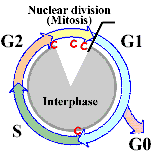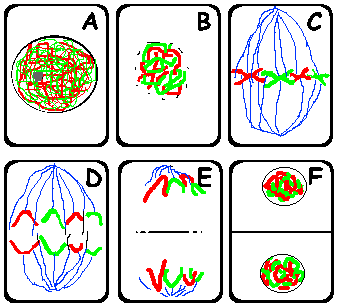Definition, function and timing of the mitosis

Mitosis is the type of division that gives rise to daughter cells for the purpose of tissue growth, regeneration or asexual (vegetative) reproduction. After mitosis and cytokinesis the daughter cells contain the same information for properties for heredity as the mothercell:
mother cell and daughter cell are genetically identical.
The mitosis follows up the G2-phase of the interphase in the cell cycle. The DNA is already duplicated and controled by then. At the beginning of mitosis the nuclear envelop disappears and the chromosomes condense strongly by folding in a spiral-like way around protein molecules. Being compact the chromosomes can be more easily separated over the daughter nuclei than if they would be unfolded. Condensed single chromosomes can be well visualized under a light microscope.
Schematically: for diploid mothercells (for example cells of a leaf)

or if the mothercell was haploid (e.g. the
thallus in liverworts)

Interphase and mitosic stages
Interphase (inter = in between): the interphase is the longste lasting stage of the cell cycle. Interphase is considered as the phase during which cells conduct their "normal" cellular functions, i.e. take up nutrients, grow, read DNA and produce proteins, and prepare themselves for the mitosis, in particular by replicating their DNA.
Prophase (pro = before): the preparative phase. This is the first stage of mitosis. The chromosomes begin to spiralize and the nuclear membrane and nuclear bodies (nucleoli = place in the nucleus active in the synthesis of ribosomes) disappear. The centrosomes (consisting each of a pair of centrioles - only in animal cells) that have been duplicated during the G2-phase separate now. All chromosomes become visible and consist now of two chromatids that are joined together at the centromere. Photographs of early, mid and late prophase stage.
Metaphase (meta = mid): the middle phase. At metaphase all chromosomes are completely spiralized and move to the middle of the cell (equatorial plane; see micrographs (made by Dilixiati Hasimu)of a polar and side view of metaphase in a Solanacea). A spindle of microtubules (thread-like structures made of tubulin polymers) is formed from pole to pole (from the centrioles in animal cells) and from pole to centromere. (view of prometaphase, metaphase and late metaphase in Bellevalia)
Anaphase (ana = upper): the separation phase. The two chromatids of each chromosome are pulled apart by the microtubules attached to the kinetochore (= a specialized area of the centromere) in the direction of the opposite poles. Each single chromatid can be regarded as the new chromosome from now on. (view of early anaphase and mid anaphase in Bellevalia)
Telophase (telos = end): the final phase. This is the conclusion of nuclear division. The spindle disappears, the chromosomes despiralize, a new nuclear envelop is formed and the new nucleoli are visible (view of early telophase and telophase in Bellevalia)
Cytokinesis (kytos = hollow vessel = cell, and kinesis = movement): the two daughter cells become independent. During cytokinesis (example in Bellevalia) that follows up the actual mitosis, the cytoplasm of the daughter cells is divided by a cell membrane (and in plants also a cell wall) in two single compartments. In animal cells the separation of the new cells involves a cleavage furrow that pinches the cell membrane. In plants, this process is characterized by the formation and growth of a cell plate (example in Solanum sp.) that expands from the space between the two daughter nuclei towards the cell periphery. Sometimes remants of the spindle (phragmoplast) are involved in the attachment of this new wall.
 Mitosis is the type of division that gives rise to daughter cells for the purpose of tissue growth, regeneration or asexual (vegetative) reproduction. After mitosis and cytokinesis the daughter cells contain the same information for properties for heredity as the mothercell: mother cell and daughter cell are genetically identical.
Mitosis is the type of division that gives rise to daughter cells for the purpose of tissue growth, regeneration or asexual (vegetative) reproduction. After mitosis and cytokinesis the daughter cells contain the same information for properties for heredity as the mothercell: mother cell and daughter cell are genetically identical.
